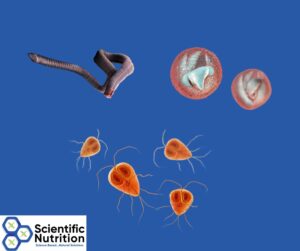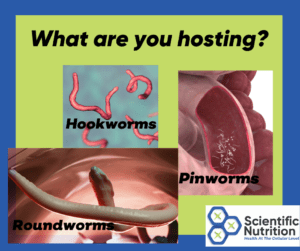andUnveiling the Dark Secrets: Human Parasites –
Food Sources, Environmental Hazards, and the Mysterious Connection to the Full Moon
Parasites have long been a subject of fascination and disgust, often associated with unsanitary conditions and poor hygiene. However, these tiny organisms have a much closer relationship with humans than we might think. From food sources to environmental hazards, parasites have a significant impact on our daily lives. In recent years, scientific research has also unearthed a mysterious connection between parasites and the phases of the moon. This blog post aims to unveil the dark secrets of human parasites, exploring their food sources, the environmental hazards they pose, and their intriguing relationship with the full moon.
How do you KNOW if have parasites or not?
There are different categories of parasites such as roundworms, single-cell parasites, tapeworms, flukes, and spirochetes. Most of us are aware of the roundworms that are often found in animals or the protozoan type in water that gives us diarrhea.
I want to share a few single-celled parasites that can cause big problems even if we can’t see them. If we can identify the symptoms we can find natural solutions to them or be proactive in killing any possibility of housing them.
They can form a stage of resting and resisting the environment until they are ingested. The good news is our bodies are pretty good at killing or keeping them under control unless we are stressed causing a weakened immune system, nutritionally deficient, or toxic with heavy metal accumulation.
In close quarters such as hospitals, daycare centers, or colleges it is easier to spread them. Another factor is infected food or the person who prepares it (think Typhoid Mary). They can form cysts to spread in the air, soil, or water.
There are many species of microscopic single-celled parasites including:
*Dientamoba and Chilomastix will infect digestive tracts.
*Cryptosporidium which can cause deadly dehydration due to diarrhea.
*Babesia lives within red blood cells and is frequently a co-infection with Lyme’s.
*Isospora destroys intestinal cell surfaces.
*Balantidium takes over the intestines releasing hyaluronidase destroying tissues.
*Pneumocystis infects the lungs, particularly in little children and auto-immune-deficient individuals.
*Sarcocystis releases toxins that destroy muscle tissues with infection.
By identifying symptoms, you can run a blood test for a specific one or two that may be causing you some issues.
What diseases can single-celled parasites cause?
Protozoan parasites can be found in large numbers within those with the following:
- Cancers- Lymphoma, Leukemia
- Rheumatoid arthritis
- Ovarian cysts
- Hodgkins disease
- Multiple Sclerosis (MS)
- Diabetes
- Colitis
- Asthma
- Degenerative muscle diseases
- Psoriasis
- High white cell counts
- Pyorrhea
- Skin ulcers
- Papular lesions
- Dermatitis
What are some of the symptoms are of parasite infections?
- Nighttime teeth grinding or clenching
- Anemia
- Lung infections
- Gallbladder issues
- Gut dysfunction
- Gum disease
- Heavy metal toxicity
- Weight loss
- Snoring
- Allergies
- Rheumatoid arthritis
- Fatigue
- Eye infections
- Intestinal gas
- Asthma
- Eczema, psoriasis or rash
- Multiple Sclerosis
- Night sweats
- Urinary tract infection
- Rosacea
- Hashimoto’s thyroiditis
- Blood sugar Imbalance
- Digestion issues
- Restlessness
- Weight Gain (especially around a full moon being that they are most active)
They give off toxic waste that can make you feel even worse. If you are suffering from these, you will want to reach out to start a nutritional building program and detoxification with me to get through the process comfortably. One indicator is notable marks on the arch or insole of the feet on the bottom or sides. If you have had the pandemic shot be aware of injectable parasites.
Uncovering the sources of human parasites in our food
When it comes to the presence of parasites in our food, it is important to be aware of the potential risks and take necessary precautions to ensure our health and well-being. Various sources of food can harbor parasites, and understanding these sources can help us make informed choices and reduce the chances of parasite infestations.
- Contaminated water sources:
Water is a common medium through which parasites can enter our food chain. Contaminated water sources, such as rivers, lakes, or improperly treated municipal water supplies, can harbor parasites like Cryptosporidium and Giardia. These parasites can contaminate fruits, vegetables, and other produce if they are irrigated or washed with contaminated water. It is crucial to ensure that the water used for irrigation or washing is clean and free from any potential sources of contamination.
- Raw or undercooked meat and seafood:
Consuming raw or under cooked meat and seafood can increase the risk of contracting parasites. Parasites like Toxoplasma Gondii and Trichinella Spiralis can be present in raw or under cooked pork, while seafood like sushi and sashimi may carry parasites such as Anisakis. It is important to cook meat and seafood thoroughly to kill any potential parasites and reduce the risk of infection.
- Contaminated soil:
Parasites can also be present in soil, especially if it has been contaminated with feces from animals or infected individuals. Fruits, vegetables, and other crops that come into contact with contaminated soil can be potential sources of parasites. It is essential to wash and properly clean fruits and vegetables before consumption to remove any potential parasites or their eggs. Some specific foods that should be avoided are tomatoes, potatoes, red peppers, and eggplant as they are favorites of a few of them.
Food and parasites-
- Improper handling and hygiene practices:
Poor food handling and hygiene practices can contribute to the spread of parasites. Cross-contamination between raw and cooked foods or unclean utensils can lead to the transfer of parasites. It is crucial to practice proper food handling and hygiene, such as washing hands thoroughly before and after handling food, using separate cutting boards for raw and cooked foods, and maintaining clean kitchen surfaces and utensils.
- Inadequate food storage:
Improper storage of food can also increase the risk of parasite infestations. Parasites can multiply and thrive in food that is not stored at the correct temperature or for an extended period. It is essential to store perishable foods, such as meat, dairy products, and leftovers, in the refrigerator at the recommended temperature to prevent the growth and multiplication of parasites.
How to avoid all of the parasites?
Understanding these sources of human parasites in our food can help us make informed choices and take preventive measures. By practicing good hygiene, properly cooking and storing food, and being mindful of potential contamination sources, we can significantly reduce the risk of parasite infestations and enjoy a healthier and safer dining experience. Bi-annual usage of anti-parasitics is a must!
In the next section, we will explore the environmental hazards associated with parasites and their potential impact on human health.
Environmental hazards: A breeding ground for parasitic infestations
The presence of parasites in our environment can pose significant risks to human health. Various environmental factors can contribute to the breeding and transmission of parasites, leading to potential infestations and related health issues. It is crucial to be aware of these environmental hazards to take appropriate measures and protect ourselves from parasitic infections.
Poor sanitation and hygiene practices
Inadequate sanitation and poor hygiene practices can create ideal conditions for parasites to thrive. Lack of clean water, improper waste disposal, and unsanitary living conditions can contribute to the spread of parasites. In areas with poor sanitation, parasites can contaminate water sources, making it more likely for individuals to ingest or come into contact with them. Practicing good hygiene, such as washing hands regularly and maintaining clean living spaces, is essential in preventing parasitic infestations.
Unsanitary farming and agricultural practices
Parasites can also be prevalent in agricultural settings where animals are raised for food production. Unsanitary farming practices, such as overcrowding, lack of proper waste management, and inadequate animal health measures, can increase the risk of parasites spreading among livestock. Consuming products derived from infected animals, such as meat and dairy, can lead to human parasitic infections. It is crucial for farmers to implement proper hygiene and animal health protocols to prevent parasitic infestations and ensure the safety of food products.
Contaminated recreational areas
Recreational activities in natural bodies of water, such as swimming or camping near lakes and rivers, can expose individuals to parasites. These water sources may be contaminated with parasites, particularly if proper waste disposal and sanitary practices are not followed. Parasitic infections can occur through accidental ingestion or contact with water containing parasite eggs or larvae. Observing hygiene practices and avoiding recreational areas with known contamination risks can help reduce the likelihood of parasitic infections.
Urbanization and deforestation
Urbanization and deforestation can disrupt natural ecosystems and increase human exposure to parasites. As natural habitats are destroyed, wildlife carrying parasites may come into closer contact with humans, increasing the risk of zoonotic diseases. Additionally, urban areas with poor waste management can attract pests that act as hosts or vectors for parasites. It is important to promote sustainable development practices that minimize the negative impact on ecosystems and prioritize public health.
Bugs and pests carry parasites
Vector-borne diseases
Vectors such as mosquitoes, ticks, and fleas play a significant role in the transmission of many parasitic diseases. These parasites rely on vectors to complete their life cycles and infect humans. Environmental factors such as stagnant water, high humidity, and dense vegetation can create favorable conditions for vector populations to thrive. Climate change can also impact the distribution and abundance of vectors, potentially increasing the risk of vector-borne parasitic diseases. Understanding and controlling vector habitats and implementing appropriate preventive measures, such as using insect repellents and bed nets, are crucial in reducing the transmission of these parasitic infections.
By understanding the environmental hazards associated with parasites, we can take proactive steps to minimize the risks of parasitic infestations. Implementing proper sanitation, hygiene, and farming practices, as well as controlling vector populations and preserving natural habitats, are essential in creating a safer environment for everyone. In the next section, we will explore the mysterious connection between parasites and the full moon. By examining the available evidence, we can gain a better understanding of this intriguing topic and separate fact from fiction.
The mysterious connection between human parasites and the full moon
Throughout history, the full moon has been associated with various myths, legends, and supernatural phenomena. One intriguing belief that has persisted over the years is the idea that the full moon has a mysterious connection to human parasites. While scientific evidence may not fully support this notion, there are several interesting observations and theories that have sparked curiosity and speculation.
-
Parasitic life cycles
Many parasites, such as certain species of worms and insects, have complex life cycles that involve multiple stages and hosts. Some theories suggest that the gravitational pull of the full moon could influence the activity and behavior of parasites during specific stages of their life cycles. For example, it is speculated that the full moon may trigger the release of parasite eggs or larvae into the environment, increasing the likelihood of infection.
- Increased host activity
Another theory proposes that the full moon might affect the behavior and activity of host organisms, making them more susceptible to parasitic infections. It is suggested that the illumination of the moon during a full moon night could disrupt the normal biological rhythms and behaviors of animals, potentially compromising their immune systems and making them more vulnerable to parasites.
- Human behavior and exposure
The full moon has long been associated with changes in human behavior, including increased activity, altered sleep patterns, and even heightened aggression. Some researchers speculate that these behavioral changes, combined with a potential increase in outdoor activities during full moon nights, could result in greater exposure to parasites. For example, individuals may be more likely to engage in activities such as camping or swimming during full moons, which could lead to increased contact with parasite-infested environments.
What about parasites found in the water?
Lunar influence on waterborne parasites
Waterborne parasites, such as certain species of protozoa, are known to pose significant health risks. Some studies have suggested a potential link between the lunar cycle and the prevalence of waterborne parasites. It is theorized that the gravitational effects of the moon could impact the movement and distribution of water, potentially affecting the concentration and dispersal of parasites in aquatic environments.
Cultural beliefs and folk traditions
The belief in a connection between human parasites and the full moon is not purely rooted in scientific observation. Cultural beliefs and folk traditions have played a role in perpetuating this idea. In many cultures, there are superstitions and practices associated with the full moon, including rituals aimed at warding off evil spirits or preventing parasitic infections. While these beliefs may lack scientific basis, they reflect the enduring fascination and mystery surrounding the full moon-parasite connection.
While the scientific community continues to explore these theories and investigate any potential links between the full moon and human parasites, it is important to approach these ideas with a critical mindset. The field of parasitology is complex, and factors such as climate, environment, and host susceptibility play significant roles in the transmission of parasites.
What are symptoms of parasites in humans with some of the common types?
Let’s examine a few single-cell parasites to look for possible issues!
GIARDIA
Giardia primarily lives in the small intestine but occasionally in the gall bladder as I learned when my daughter was infected. It can cause damage to the intestinal walls or impede enough bile from leaving the gall bladder to break down fats. Diarrhea will follow with visible fat in the toilet, gas, nutrient deficiencies of fat-soluble vitamins, and abdominal cramping. Often meat and lactose intolerance come with the territory as well.
It can be found in contaminated feces and passed when diapers are changed, infected clothing, and contaminated food. It can be found in water sources such as streams, mountain waters, and even municipal water sources that use chlorination or filters.
Let’s examine a few single-cell parasites to look for possible issues!

CRYPTOSPORIDIUM
This is another parasite that causes flu-like symptoms, stomach cramping, and diarrhea. It has been seen in water, which since 1994, has become immune to chlorine. The small eggs are so minute that at least 33% of them get past testing in large city municipal drinking water.
You can find many reports online of contamination across the United States from San Francisco to New York.
TOXOPLASMOSIS
Do you own a cat?
Many animals will harbor this parasite but it is well known that cat boxes are a no-no with pregnant women. It crosses over into the baby’s brain and spinal cord triggering hydrocephalus (water on the brain), decreased head and brain size, seizure, mental retardation, paralysis, stillbirth, and spontaneous abortion. Cats also carry Neospora protozoan cousin to this Toxoplasma Gondii but by estimates at least 40% of cats carry toxoplasmosis but dogs, mice, rats, and gerbils can carry it as well.
Other sources are undercooked pork, mutton, beef, or chicken. Environmental contaminations come from flies or cockroaches that spread the encysted parasites onto food.
Testing for antibodies to this bugger is a better indicator as symptoms can take years to show up. They may be mistaken for run-of-the-mill influenza or pneumonia. One will feel headaches, swollen lymph glands, fever, chills, and serious fatigue. As they move into the organs (liver, heart, brain, or eyes) they will cause damage.
A good reason why symptoms of stomach ulcers should be addressed beyond acid reflux medications?
A good reason why symptoms of stomach ulcers should be addressed beyond acid reflux medications?
AMEBA
These microscopic organisms cause similar symptoms as Giardia but are much more common. One difference however is that Corticosteroid medications such as asthma inhalers or steroids. They will cause lesions or ulcers in the intestines called an ameboma that appears as a ring in the tissue. Once established it causes amebic dysentery (diarrhea).
Avoiding high carbohydrate diets is very important and boiling water before drinking it if it’s a suspected source. Other strains are in the liver, brain, and inside the mouth. This Ameba is a single-celled parasite but is nothing to be ignored.
Hair Analysis and parasites
There are natural modalities to knock these offenders out of the body. They can carry up to 10X their body weight in heavy metals sparing you of other issues temporarily. Once you detoxify them they release the metals BUT…then you must deal with that. A hair analysis test can see if you have mineral dificiencies that are hampering your ability to eliminate them.
Ensuring a parasite-free future
When you rebuild your mineral deficiencies with dietary changes, supplement with exactly what your body needs, and practice detoxification modalities you can kill them while feeling comfortable! I hope you see the importance of awareness and vigilance.
Figuring out the “how” is where Hair Analysis and my coaching come in. LET’S CHAT if you are ready to kick them to the curb and reclaim your health!
Learn more about What types of parasites live in a human.
Copyright Scientific Nutrition, LLC 2021




